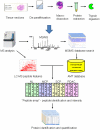Proteomics portrait of archival lesions of chronic pancreatitis
- PMID: 22132114
- PMCID: PMC3223181
- DOI: 10.1371/journal.pone.0027574
Proteomics portrait of archival lesions of chronic pancreatitis
Abstract
Chronic pancreatitis is a chronic inflammatory disorder of the pancreas. The etiology is multi-fold, but all lead to progressive scarring and loss of pancreatic function. Early diagnosis is difficult; and the understanding of the molecular events that underlie this progressive disease is limited. In this study, we investigated differential proteins associated with mild and severe chronic pancreatitis in comparison with normal pancreas and pancreatic cancer. Paraffin-embedded formalin-fixed tissues from five well-characterized specimens each of normal pancreas (NL), mild chronic pancreatitis (MCP), severe chronic pancreatitis (SCP) and pancreatic ductal adenocarcinoma (PDAC) were subjected to proteomic analysis using a "label-free" comparative approach. Our results show that the numbers of differential proteins increase substantially with the disease severity, from mild to severe chronic pancreatitis, while the number of dysregulated proteins is highest in pancreatic adenocarcinoma. Important functional groups and biological processes associated with chronic pancreatitis and cancer include acinar cell secretory proteins, pancreatic fibrosis/stellate cell activation, glycoproteins, and inflammatory proteins. Three differential proteins were selected for verification by immunohistochemistry, including collagen 14A1, lumican and versican. Further canonical pathway analysis revealed that acute phase response signal, prothrombin activation pathway, and pancreatic fibrosis/pancreatic stellate cell activation pathway were the most significant pathways involved in chronic pancreatitis, while pathways relating to metabolism were the most significant pathways in pancreatic adenocarcinoma. Our study reveals a group of differentially expressed proteins and the related pathways that may shed light on the pathogenesis of chronic pancreatitis and the common molecular events associated with chronic pancreatitis and pancreatic adenocarcinoma.
Conflict of interest statement
Figures








Similar articles
-
Role of YAP and TAZ in pancreatic ductal adenocarcinoma and in stellate cells associated with cancer and chronic pancreatitis.Sci Rep. 2015 Nov 16;5:16759. doi: 10.1038/srep16759. Sci Rep. 2015. PMID: 26567630 Free PMC article.
-
[Preferential expression of cartilage oligomeric matrix protein in degenerating acinar cells in chronic pancreatitis and in chronic pancreatitis-like lesions].Zhonghua Wai Ke Za Zhi. 2003 May;41(5):328-31. Zhonghua Wai Ke Za Zhi. 2003. PMID: 12892583 Chinese.
-
Transient and ectopic expression of lumican by acinar cells in L-arginine-induced acute pancreatitis.Exp Mol Pathol. 2003 Feb;74(1):33-9. doi: 10.1016/s0014-4800(03)80006-0. Exp Mol Pathol. 2003. PMID: 12645630
-
Unraveling the Connection Between Ion Channels and Pancreatic Stellate Cell Activation.Cell Physiol Biochem. 2025 Jan 18;59(S1):25-40. doi: 10.33594/000000754. Cell Physiol Biochem. 2025. PMID: 39825736 Review.
-
Pancreatic stellate cell: Pandora's box for pancreatic disease biology.World J Gastroenterol. 2017 Jan 21;23(3):382-405. doi: 10.3748/wjg.v23.i3.382. World J Gastroenterol. 2017. PMID: 28210075 Free PMC article. Review.
Cited by
-
Advanced imaging techniques for chronic pancreatitis.Abdom Radiol (NY). 2020 May;45(5):1420-1438. doi: 10.1007/s00261-019-02191-0. Abdom Radiol (NY). 2020. PMID: 31428813 Free PMC article. Review.
-
Expression of small leucine-rich extracellular matrix proteoglycans biglycan and lumican reveals oral lichen planus malignant potential.Clin Oral Investig. 2018 Mar;22(2):1071-1082. doi: 10.1007/s00784-017-2190-3. Epub 2017 Aug 4. Clin Oral Investig. 2018. PMID: 28779221
-
Laser Capture Microdissection of Pancreatic Acinar Cells to Identify Proteomic Alterations in a Murine Model of Caerulein-Induced Pancreatitis.Clin Transl Gastroenterol. 2017 Apr 13;8(4):e89. doi: 10.1038/ctg.2017.15. Clin Transl Gastroenterol. 2017. PMID: 28406494 Free PMC article.
-
Advances in acute and chronic pancreatitis: from development to inflammation and repair.Gastroenterology. 2013 Jan;144(1):e1-4. doi: 10.1053/j.gastro.2012.11.018. Epub 2012 Nov 15. Gastroenterology. 2013. PMID: 23159450 Free PMC article. No abstract available.
-
Advanced MR Imaging of the Pancreas.Magn Reson Imaging Clin N Am. 2020 Aug;28(3):353-367. doi: 10.1016/j.mric.2020.03.003. Epub 2020 Jun 3. Magn Reson Imaging Clin N Am. 2020. PMID: 32624154 Free PMC article. Review.
References
-
- Bhuiya FA, Pitts SR, McCaig LF. Emergency department visits for chest pain and abdominal pain: United States, 1999–2008. NCHS Data Brief. 2010:1–8. - PubMed
-
- Everhart JE, Ruhl CE. Burden of digestive diseases in the United States Part III: Liver, biliary tract, and pancreas. Gastroenterology. 2009;136:1134–1144. - PubMed
-
- Spanier BW, Dijkgraaf MG, Bruno MJ. Trends and forecasts of hospital admissions for acute and chronic pancreatitis in the Netherlands. Eur J Gastroenterol Hepatol. 2008;20:653–658. - PubMed
-
- Lowenfels AB, Maisonneuve P, Cavallini G, Ammann RW, Lankisch PG, et al. Pancreatitis and the risk of pancreatic cancer. International Pancreatitis Study Group. N Engl J Med. 1993;328:1433–1437. - PubMed
-
- Lowenfels AB, Maisonneuve P, Dimagno EP, Elitsur Y, Gates LK, et al. Hereditary pancreatitis and the risk of pancreatic cancer. International Hereditary Pancreatitis Study Group. J Natl Cancer Inst. 1997;89:442–446. - PubMed
Publication types
MeSH terms
Substances
Grants and funding
LinkOut - more resources
Full Text Sources
Other Literature Sources
Miscellaneous

